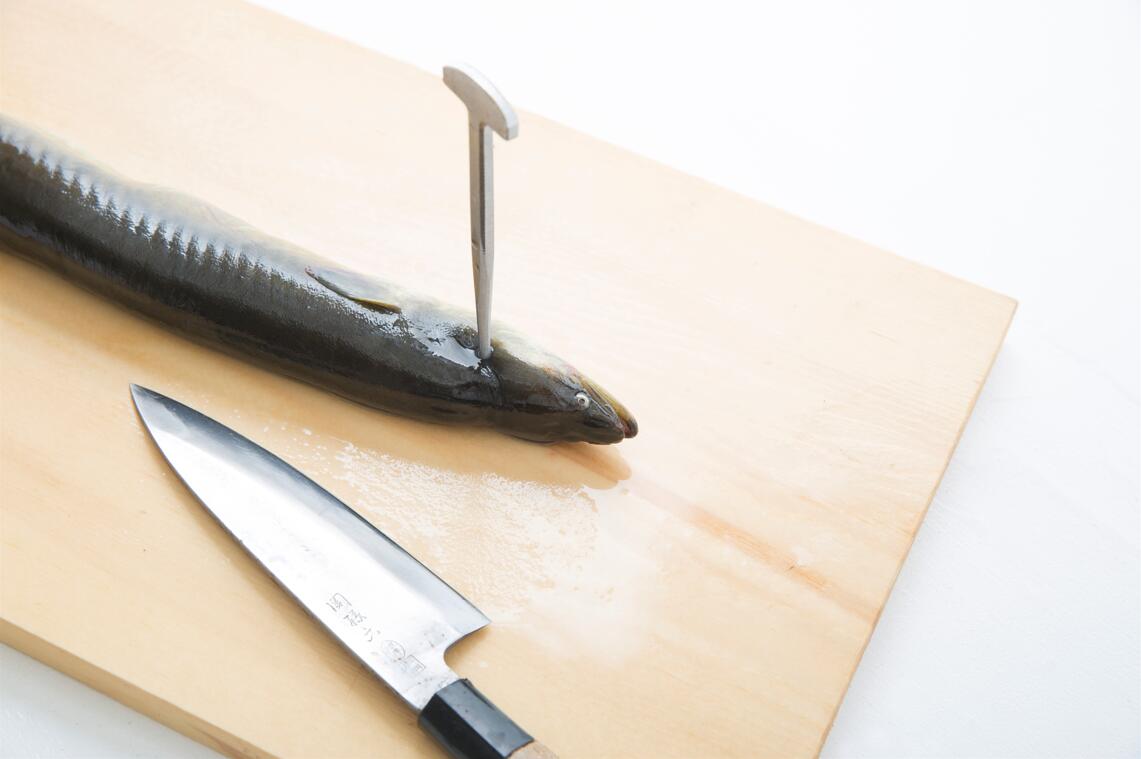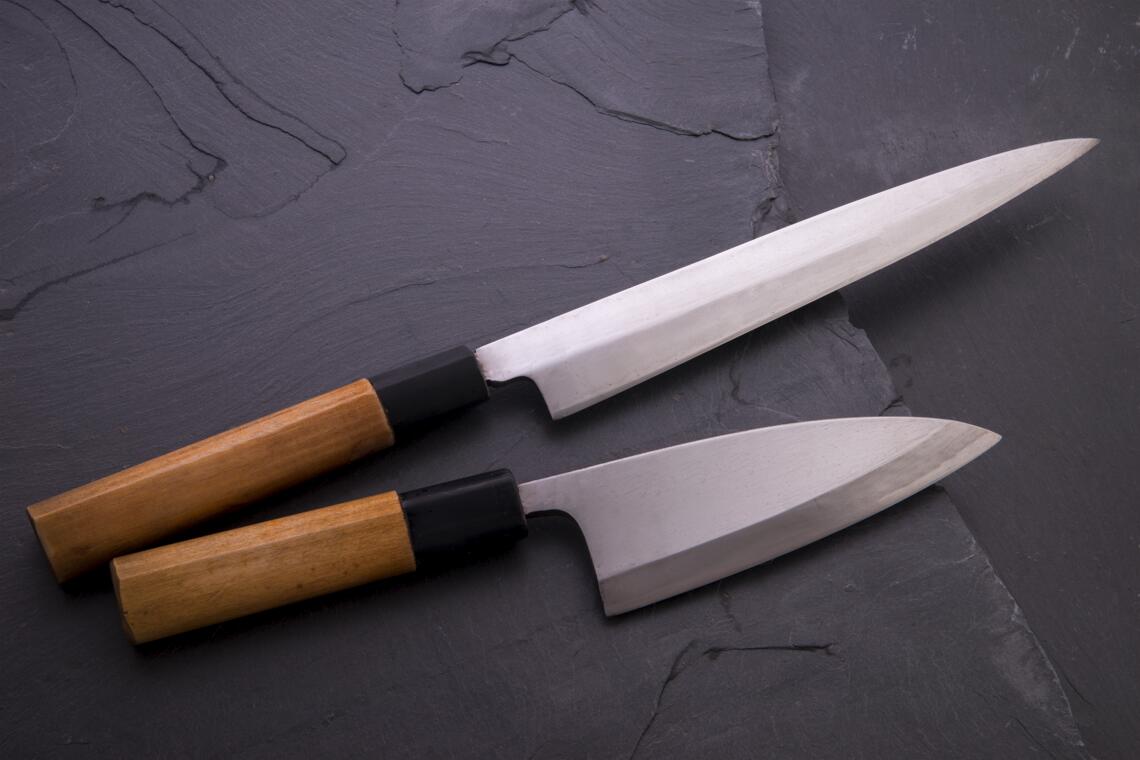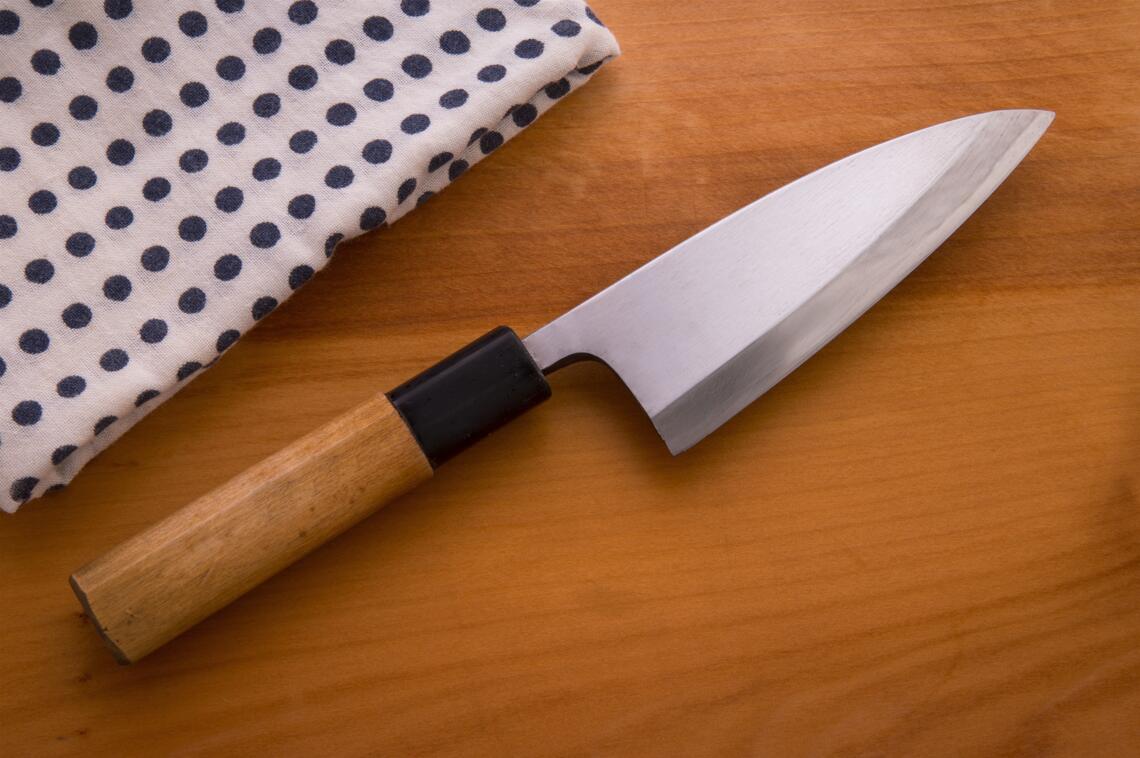Japanese kitchen knives come in a great variety. Some of these knives have specific purposes that make them excellent at one task in particular.
A great example of this is the Deba knife. This Japanese knife excels at butchering and filleting fish. Although it looks completely different than a traditional western knife used for filleting fish, its features make it the perfect tool for working with fish.
This article will cover everything you need to know about the Japanese Deba, its varieties, and things to consider when buying one.
Table of contents
Deba knife characteristics
Blade profile
Deba has a thick spine and a single bevel edge. This cutting edge helps to fillet fish without tearing it apart, and the blade slides right through the whole body in a single sweep. The blade design is similar to western chef’s knives but broader. Contrary to traditional western filleting knives that are thin and flexible, the Deba knife is more versitile requiring both force and precision when working with fish.
Thickness
Deba is a bit thicker than other single-bevel Japanese knives life yanagiba but thinner than a chef’s knife.
Weight
Deba is unconventionally heavier than you would expect from a Japanese knife. The blade profile and the extra thickness adds weight to the knife. While most Japanese knives are lighter, this excess weight in Deba is handy when beheading fish, especially large ones. The extra weight doesn’t become a disadvantage when filleting and doing other delicate work as it’s single beveled, becoming an advantage in tasks that require force while maintaining the intricacy.
Size
Deba knife comes in a great variety of lengths. You can get a Japanese Deba as small as 5 inches and as big as 12 inches. The size depends on the fish you’re butchering. Japanese chefs usually utilize more than one Deba knife to fillet different fish. The length of the blade should always be longer than the width of the fish you’re filleting, and keep that in mind when buying one.
Handle
An overwhelming majority of Deba knives are equipped with traditional Japanese handles, also known as wa-handles. Although there are varieties of Deba with western yo-handles, they are rather hard to come by.
Steel
Traditionally, Deba is made from high carbon steel. To this day, most Japanese chefs prefer carbon steel over stainless steel alternatives. However, this doesn’t mean you can’t get a stainless steel Deba.
Deba knife uses

The Japanese Deba knife is mainly for butchering and filleting fish. It can also be used for butchering meat but not large cuts of meat with bones. The edge is more prone to chip due to the single bevel when cutting dense ingredients.
Although it’s fragile enough, you can still use it to cut and break down poultry with small bones. Anything denser than this, you’ll run into problems. Instead, look for sturdier options like the HDMD Serbian Chef’s Knife we have in our store.
There are a couple of things that make Deba great at filleting fish. The single bevel cutting edge slides right under the fish’s backbone, creating intact and tear-free fillets. The thick spine also allows for powerful cuts like cutting the heads where you would need the assistance of a chef’s knife or a hammer if you were to use a thin filleting knife.
Overall, Deba is the Japanese equivalent of a filleting knife for fish despite having an entirely different blade design.
Deba variations

As mentioned, there are different varieties of Deba. Each type offers a unique feature. If you’re butchering lots of fish, it won’t be hard to find the perfect Deba to work with, considering the plenty of options available.
Hon Deba
Hon-Deba, also known as the true Deba, is the standard variation of Deba that has all the features explained above. The most notable characteristic of Hon-Deba is how the thickness tapers down at its length from the heel to the tip. Deba has a thick spine, but it gets considerably thin at the tip, allowing you to make intricate cuts while also noticing when contacting the bones.
Mioroshi Deba
Mioroshi-Deba has a more narrow and thin blade profile than the standard Deba. It is used for filleting but can also be an appropriate tool to slice fish finely. It’s commonly seen as a fish knife between Yanagiba and the standard Deba. However, Mioroshi-Deba is a lot more fragile. If operated incorrectly, the blade may get damaged. Mioroshi-Deba is in better hands if you have experience filleting and slicing fish. If not, the standard Deba may be a better option.
Ai Deba
Ai-Deba will be the best alternative if you find the Hon Deba heavy. It features the same blade design but is a tad bit narrower. It’s also thinner, which makes it suitable for slicing fish. Ai-Deba is easier to handle and lighter than the standard Deba and other similarly sized variations. If you’re looking for a Deba to both fillet and slice fish, it’s the best option.
Ko Deba/Ajikiri
A small variation of the Deba with many names, Ko-Deba is pretty much the same as the standard Deba with a much shorter blade. It’s generally between 4 and 5 inches long. It’s at the optimum length for most home cooks preparing small and medium-sized fish like trout. This type of Deba is also known as Aji-Kiri and Aji-Deba.
Ryo Deba/Wa Deba
Ryo-Deba or Wa-Deba is the double bevel alternative to the typical single bevel Deba. The blade design, size, and weight are the same as the hon Deba, with the only difference being the edge. If you’re left-handed or prefer double bevel knives, Ryo-Deba is the singular available option for the Hon-Deba.
Deba vs. fillet knife
The Japanese Deba is a specialty knife for beheading and filleting fish. On the other hand, the filleting knife can be used for a variety of tasks but mainly filleting, as the name suggests.
When working with fish, certain things make Deba a more convenient choice, like cutting the head off. It’s incredibly challenging to cut through even the medium-sized fish heads with a filleting knife where you’d need a secondary knife or a hammer. This isn’t a problem for Deba as the broader blade in comparison, and the weight allows removing the head much more easily.
This alone doesn’t make Deba a better knife than your typical filleting knife. It comes down to preferences and the type of fish you’re cutting. If you’re comfortable with your filleting knife and don’t find yourself looking for anything extra, keep on using it. However, when cutting large fish, you can utilize Deba from start to finish without the need for another knife or tool.
How to choose the right Deba?

Finding the right Deba for your kitchen with the different variations can be overwhelming. Unless you’re planning on equipping yourself with multiple Deba knives, we highly suggest taking a look at the types of fish you cut the most. This can reveal which Deba is best for you, but the following can help you determine if that’s not enough.
Blade length
The size is the first thing to get out of the way. As the fish you often cut changes, so will your needs. For example, if salmon is a common fish in your diet, a Ko-Deba will give you more challenges than comfort. On the other hand, a standard Deba will be the right choice.
The larger the fish gets, the more blade you’ll need to fillet. A standard Deba with a length of 10 to 12 inches is the right choice if you’re cutting larger fish.
On the flip side, a big blade won’t be the right choice if you’re cutting smaller fish like herring. Filleting and slicing a large fish with a large blade requires a lot of stability and experience.
Once you figure out the size you need, look at the other attributes you would like to have. If you enjoy what the Deba offers but find it a bit heavy or don’t need that much blade width, go with an Ai-Deba. Maybe it’s something thinner you need. In that case, a Mioroshi-Deba could provide you with the delicacy you anticipate.
Handle design
Other than the steel, pay attention to the handle and hold it if possible when shopping. If it doesn’t feel comfortable, then chances are you won’t find it satisfying to use. Deba, like other Japanese knives, has the traditional Japanese handle. If you’ve never used a knife with a Japanese handle, you may not like the grip at first as they don’t provide that firm, sturdy hold around the handle.
However, considering the type of work you’ll do with a Deba, you won’t need that firm grip around the handle. Japanese handles are just as comfortable as western handles once you get the hang of them. Nevertheless, you can get the Japanese Deba fitted with western handles instead of the traditional hexagonal Japanese handles.
Caring
Lastly, consider the care the knife requires. Some don’t want to put time and effort into knife caring, and these don’t align well with carbon steel knives. You must show a little more care to a carbon steel knife than a stainless steel one.
These care requirements are nothing extremely demanding, though. All you’d need to do with a carbon steel knife is dry it immediately after use, apply food-grade mineral oil when storing it, and not wash it in the dishwasher. As long as you do these, your knife will thank you and show its true worth throughout its lifetime.
Still, if these sound too much work, you can always get yourself a stainless steel alternative. Luckily, many modern Japanese knives, including the specialty knives like the Deba, have stainless steel options.
Ending
The Japanese Deba is a specialty knife with a specific purpose in mind. These knives aren’t all-purpose knives, and utilizing them in every ingredient can damage the blade. If you’re looking for a knife to fillet whole fish, Deba is undoubtedly a great tool that will give you an easier time. If an all-rounder Japanese kitchen knife is what you need, opt for a gyuto or kiritsuke instead. Learn more about different kitchen knives on our blog.









